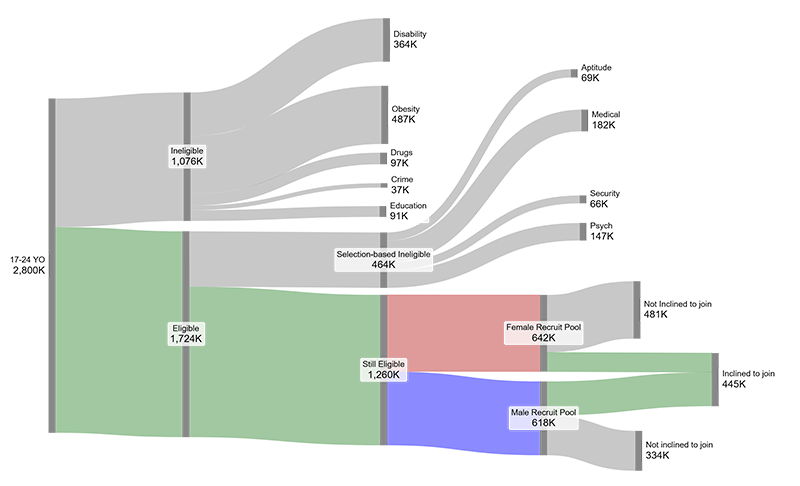Abstract
The Australian Defence Force requires thousands of new recruits each year, most of whom are recruited from the target demographic of 17-24-year-old Australians. However, when national characteristics such as health, criminality and education are combined with the ADF’s own selection criteria and the willingness of individuals to join the military, the proportion of the target demographic eligible and willing to join diminishes substantially. It is estimated that just 16% of 17-24-year-olds are eligible and also have a propensity to join the ADF.
Introduction
Every year the Australian Defence Force (ADF) requires somewhere between 5,500 and 8,200 entrants for the permanent force, and an additional 2,300 for the Reserves, most of whom will have had no previous military service.[1] Yet it perpetually struggles to reach this target, having never fully achieved its recruiting objective. With recent recruiting outcomes substantially below desired levels,[2] it seems that recruiting up to 10,500 people from 2.8 million Australians in the recruiting demographic of 17-24-year-olds (and many more in older age groups), is a difficult endeavour.
In this article, the size of the Australian population is explored in more detail to determine how many 17-24-year-olds are eligible to join the ADF against the most basic of criteria and, of those, how many have the propensity (willingness or inclination) to join. This article does not explore the reasons why people don’t join, nor examine the competitiveness of the employment value proposition or delve into the impact of the Australian civil-military relationship on recruiting; it is simply an overview of the numbers available to join. This article aims to demonstrate that although the national population base is large, some characteristics of the population, combined with military selection criteria and propensity to join, substantially reduces this number, making the recruiting target deceptively difficult to obtain.
Article Limitations
The data used in this article are not necessarily from the same source and individuals are not identifiable at an individual level. As a result, it is likely that in some circumstances there will be overlaps, or interactions, between certain variables that cannot be quantified. For example, there may be a relationship between criminality and drug use. Because the variables are not adjusted for (unknown) interactions, there may be a tendency toward deeming more people ineligible for the ADF than is actually the case; however, this known error is minimised through a generous application of criteria whereby more people are assumed to be eligible than not when a range is available.
This article examines the eligibility and propensity to join for the 17-24-year-old age group, collectively referred to as the ‘typical recruiting demographic’. This age group is the most decisive demographic in achieving recruiting targets due to its size and high proportion concurrently looking to enter the workforce, with fewer disqualifying characteristics, and a high propensity to join. Since 2002, this group has accounted for 79% of ab initio (new) entrants into the permanent force.[3] Recruiting from the 17-24-year-old age group dominates the opportunity for the ADF to meet the majority of its targets.
Method
In estimating the proportion of the national population who might be eligible to join the ADF, two groupings of criteria that reduce the size of the eligible pool are explored. First, those national characteristics of 17-24-year-old Australians that disqualify them from applying for any role in the ADF in the broadest sense are considered. These include physical or mental disability, macro-health concerns (as measured by a proxy of obesity), criminality, illicit drug use, and achievement of minimum eligibility education levels. Official data from government sources are available in each of these areas. There are other characteristics that could have been included in this first grouping; however, these five national characteristics represent the largest overall impact on reducing the size of the eligible population.
The second grouping comprises those internal ADF general selection criteria that further narrow and refine the eligibility of 17-24-year-olds over and above disqualifying national characteristics, and for which only ADF data exists. These include aptitude (including cognitive ability), specific medical suitability, psychological suitability, and the ability to achieve a security clearance. Again, there are other selection criteria; however, these four are the most influential in reducing the size of the eligible population.
Propensity to join is broadly defined as how likely a person is ‘to ever consider a job with the Navy, Army or Air Force’ and is the critical second dimension in determining the possible size of the population from which the ADF can potentially recruit.[4] Propensity, normally sub-categorised by gender and age, is routinely obtained by Defence Force Recruiting (ADF Careers) through market research. Although the combination of national characteristics and internal selection criteria will help estimate the number of 17-24-year-olds eligible to join the ADF, this does not mean that they necessarily have a propensity to join. When the propensity to join is overlaid on eligibility figures, the proportion of the population that have both the eligibility and propensity to join can be obtained.
National Characteristics
Population size. The start-state in determining the proportion of 17-24-year-olds who may be eligible to join the ADF is understanding the size of this cohort. Using a mid-range projection (medium fertility, high life expectancy and medium net overseas migration), the population of Australian 17-24-year-olds in 2025 is estimated to be around 2.8 million, which is approximately 10% of the national population and comprised of 51% female. This number is projected to increase to 3.1 million before 2031 when it may comprise 10.5% of the national population before decreasing below 9% near 2050.[5]

Disability. In 2022, 14.4% of males and 13.2% of females in the 15-24-year-old age group were reported as having a disability described as ‘… any limitation, restriction or impairment which restricts everyday activities and has lasted, or is likely to last, for six months or more’. This disability would normally deem a person ineligible to apply for a role in Defence. It has been noted by the Australian Bureau of Statistics that disability prevalence increased between 2018 and 2022, particularly in the typical recruiting demographic, and an estimate of 15% may also be plausible.[6] For the purpose of this article, it is conservatively estimated that 13% of the population aged 17-24 are ineligible to join the ADF due to a disability.

Health. Relevant public health statistics for ADF eligibility are difficult to obtain; however, obesity may be used as a proxy due to its close association with a range of health conditions. In 2022, 42% of men and 41% of women were overweight or living with obesity (15% of men and 16% of women were obese). While being overweight or obese does not necessarily make a person ineligible to apply for the ADF, the likelihood that they will not meet the medical criteria for enlistment or appointment is substantially increased. In this article it is conservatively estimated that 20% of 17-24-year-olds are ineligible to apply due to a pre-existing health issue, not associated with disability, for which overweight or obesity is a proxy.[7]

Criminality. The youth crime rate in 2022/23 was reported as 1.8% or 1,847 in 100,000 persons between the ages of 10 and 17, although it is higher in males (2.4%) than females (1.2%).[8] It was also substantially higher in 18-19-year-olds (3.2%) and in 20-24-year-olds (2.7%). Several simplifying assumptions in estimating ineligibility due to criminality are necessary. Firstly, it is assumed that the crime(s) committed deems a person ineligible to join Defence, which is normally the case. Secondly, it is optimistically assumed that there are high rates of recidivism/repeat offenders such that the figure for the crime rate does not accumulate additively over the time that a person is aged 10-24. For example, it is assumed that by the time a person is 24 years old, the accumulated likelihood of having committed a crime is not 7.7%.[9] Overall, this article makes a conservative assumption that 2% of the population aged 17-24 are not eligible to join the ADF due to a criminal background, but this figure may actually be substantially higher.

Illicit drug use. In 2019 it was reported that 24% of Australians aged 14-24 had used illicit drugs in the preceding 12 months.[10] The most commonly used illicit drugs were marijuana/cannabis, ecstasy and cocaine. Previous drug use does not necessarily deem a person ineligible for the ADF, particularly since up to 77% of 18-24-year-olds who reported using drugs did so out of curiosity; however, the use of ecstasy (7.6%) or cocaine (7.3%) would normally be of particular concern for suitability. This article estimates that previous use of illicit drugs would deem at least 5% of the population aged 17-24 ineligible to apply to join the ADF.

Education. The ADF requires at least a year 10 level of English and Mathematics to apply for some limited roles, although an increasing majority of roles require a higher level. In 2022, 90% of 20-24-year-olds had attained the national requirements for a qualification at year 12 or certificate III level or above, which included completion of year 10 English and Mathematics.[11] The National Assessment Program – Literacy and Numeracy (NAPLAN) also provides some information on literacy and numeracy levels up to year 9, indicating that 5% of Australian year 9 students are below the national minimum numeracy level, and 10% are below the minimum reading standard.[12] This article estimates that at least 5% of the recruiting demographic do not have the minimum education requirements to apply for a role in the ADF but notes that this may be higher than 10% in some aspects of literacy.
Once these national characteristics are combined, the proportion of the Australian population aged 17-24 who may be eligible to apply for any role in the ADF is reduced to below 62%, as shown in figure 1. This means that even before the ADF applies its own selection criteria to this demographic, almost two-in-five people from the recruiting demographic cannot apply (or if they were to apply would likely not proceed beyond initial stages). This figure is optimistic as a more aggressive application of assumptions, discussed later, would result in even lower rates of eligibility. Significantly, with less than two-thirds of the national population exhibiting the baseline characteristics to even apply to join Defence, a competitive employment value proposition, and presence in the mind as a career option, become paramount in attracting the recruiting demographic to take the next step in applying for a role in the ADF.
ADF General Selection Criteria

Aptitude and cognitive ability. Aptitude and cognitive ability are assessed separately from educational attainment during the selection process. There is a small but significant proportion of applicants who meet many initial application criteria but do not meet the minimum requirements of an aptitude test. Although the ADF has changed its approach to testing, with the most recent change occurring in 2020, around 4% of applicants do not meet the minimum requirement for any role.[13]

Medical suitability. In addition to ineligibility through disability or health (obesity) discussed earlier, many candidates are also found to be ineligible for Defence on other health-related grounds. The proportion of applicants unsuitable for any role on the basis of responses to a health questionnaire conducted during the recruiting process is around 11% (noting that many applicants withdraw from the recruiting process before completing the questionnaire).[14] Of those who progress beyond the health questionnaire, a further 6% of candidates are later found to be unsuitable for a role. This article conservatively estimates that 11% of the applicant pool are unsuitable for any role in Defence, but acknowledges that this figure could be substantially higher as the medical suitability of those withdrawing their application before completion of the questionnaire is unknown.

Psychological suitability (Defence Interview outcome). Potential applicants are not usually screened for psychological suitability prior to making an application as this stage occurs as part of the recruiting process. In addition to psychological suitability, applicants also undertake a Defence Interview (job interview) for suitability. The outcome of this interview is, unsurprisingly, highly correlated with the psychological interview (ie applicants found to be psychologically unsuited are also found to be unsuitable by a Defence interviewer) such that inclusion of both metrics in this analysis is unnecessary. Around 10% of applicants do not meet the psychological requirements for any role in the ADF as assessed by a psychologist.[15]

Security clearances. Increasingly, roles in the ADF require a checkable background in order to obtain the necessary security clearance. This is closely associated with an applicant’s citizenship status, and while there are avenues for some specific non-Australian citizens to apply, their background checks become increasingly difficult. An estimated 5% of applicants are unable to obtain the necessary security clearance for a role in the ADF either through a lack of supporting evidence or for another reason associated with their application itself.
Once all eligibility factors are combined (national characteristics and selection factors), around 45% of the national population of 17-24-year-olds remain eligible to join the ADF in some role. For ease of analysis, it is assumed that this comprises equal numbers of men and women.[16] In the simplest of terms, this means that of the entire population of 17-24-year-old Australians, less than one-half are actually eligible to enlist, regardless of whether they want to or not. Significantly, this population is also likely to be in high demand for a range of other occupations in Australia that have similar selection criteria. The ADF is undeniably in a competitive market for a relatively small proportion of the eligible workforce, and yet again as mentioned earlier, a competitive employment proposition and visibility of job opportunities underscores the ability for the ADF to attract sufficient numbers from this demographic to apply.
Propensity
The propensity of the Australian population to join the military is measured through independent market research and can vary in response to a range of environmental factors. Individuals may actually be ineligible to join the ADF yet indicate a propensity to join, and vice versa. Males aged 25-34 have a higher propensity to join than 15-24-year-old males, but more social and opportunity-based constraints result in a lower likelihood of them acting on their higher propensity (and subsequently applying for the ADF).[17] This is reflected in the relatively low proportion of 25-34-year-olds recruited into the ADF.[18] At all ages, males have a higher propensity than females. Currently, the propensity to join for 17-24-year-old men and women is 46% and 25% respectively[19] and it is assumed that the propensity applies equally to the entire demographic regardless of whether they may be eligible to join or not.[20]
The combination of Eligibility and Propensity
Applying a propensity to join to eligible men and women results in a figure of just 16% of all 17-24-

Figure 1. National Characteristics, Selection criteria and propensity affecting eligibility for the ADF.
This article has also made its analysis based on the eligibility of the Australian recruiting demographic for any role in the ADF with the minimum criteria. However, most applicants do not simply apply for any role, they apply for specific roles with defined selection criteria that further limit eligibility, many of which are also selective. For example, technical and submariner roles require higher aptitude and completion of year 12 (submariners require additional health attributes). Similarly, officer and pilot roles require high aptitude, completion of year 12, potential for leadership roles, and remain highly selective. In these simple examples, only a very small proportion of the recruiting demographic is eligible for the ADF. Therefore, 16% should not be interpreted as the proportion who may join the ADF; it is the generous upper limit of eligibility and propensity in the absence of further (disqualifying) selection criteria that may be relevant to those applicants applying for specific roles.
ADF’s levers and sensitivity
While many of the factors, such as obesity and criminality, are out of the ADF’s sphere of influence, it does have leverage over its own selection criteria and some influence on propensity through marketing, public profile and national sentiment. Opening the selection ‘aperture’ and the acceptance of greater levels of risk would increase the proportion eligible, but perhaps not to the extent necessary or desirable. Eligibility is more sensitive to the national factors, especially disability and health, than the ADF’s own criteria. For example, complete removal of all of the ADF’s specific selection criteria, while maintaining current propensity to join, would only result in an increase in the eligible population from 16% to 21%. Removing both the ADF’s selection criteria and improving propensity to 50% for both men and women would still only result in 31% of 17-24-year-olds being both eligible and with the propensity to join. This lack of sensitivity to the ADF’s selection criteria emphasises the significance of the national characteristics and supports a view that 16% could be considered a relatively constant and optimistic planning figure for the proportion of 17-24-year-old Australians who are both eligible and have the propensity to join the ADF.
Nevertheless, this does not mean that the ADF should avoid close examination of its selection criteria and its own influence over propensity to join. While the effect may be small in terms of overall proportion, opening the aperture around selection criteria would have an inevitable positive impact on eligibility. For example, improving medical ineligibility from 11% to 10% would increase the number of eligible 17-14-year-old Australians by over 14,000. Similarly, increasing the propensity to join by just 1 percentage point to 47% for males and 26% for females would add over 12,500 to those who are eligible and have the propensity to join. Successfully attracting even a small number from improvements such as these would contribute to a greater chance of achieving targets.
Conclusion
Not all people in the Australian recruiting demographic of 17-24-year-olds are eligible to join the Australian Defence Force, nor do they all possess the propensity or desire to join. When the various eligibility criteria for military service are overlaid against those who have the propensity to join, just 16% possess both the eligibility and propensity for service in the ADF. The use of more aggressive assumptions in the analysis suggest that this figure could be as low as 11%, and further selection criteria for specific roles that require greater levels of education, aptitude, health and potential for leadership would yield an even smaller proportion.
The relatively small proportion of Australian 17-24-year-olds eligible to the join the ADF, and who also possess the propensity to join, underscores the persistent difficulties experienced by the ADF in recruiting from this demographic. Broadening the ADF’s selection criteria may assist in some small way, but the overwhelming influence on eligibility is caused by national characteristics such as obesity, drug use, crime, and education, on which the ADF has little or no influence. Improvements in national sentiment toward the military that result in an increase in propensity to join may also assist in some small way, but the levers to do this are limited and would operate with a significant time delay. It may be an immoveable reality that the ADF will only ever be able to recruit from a relatively small proportion of the population, against which there is significant competition. Maintaining social legitimacy, offering a competitive employment value proposition, and instilling a presence in the minds of youth as a career option will remain essential in the ADF’s efforts toward recruiting for the future from a relatively small proportion of the eligible population.
Acknowledgments
The author wishes to acknowledge the support of Defence Force Recruiting/ADF Careers, in particular LTCOL Peter Scott, in the provision of key data and analysis used in this article.
1 Recruiting targets vary in accordance with workforce growth requirements, strategic guidance and recruiting outcomes in previous years. Ab initio recruiting (no previous military service) accounts for 80% of the recruiting results with transfers from the reserves, re-enlistments, and overseas military transfers providing the remainder.
2 Australian Government, Defence Annual Report 2023-24, (2024), p37. https://www.defence.gov.au/about/accessing-information/annual-reports
3 Source: PMKeyS. 25-to-34-year-olds comprise 17% of ab initio entrants. 35-to-44-year-olds comprise 3% and 45 to 60 year-olds comprise 1%.
4 Defence Force Recruiting, Hall and Partners
5 Australian Bureau of Statistics, ‘Population Projections, Australia, 2022-2071’, Data Explorer. https://dataexplorer.abs.gov.au/vis?fs[0]=People%2C1%7CPopulation%23POPULATION%23%7CPopulation%20Projections%23POP_PROJ%23&pg=0&fc=People&df[ds]=PEOPLE_TOPICS&df[id]=POP_PROJ&df[ag]=ABS&df[vs]=1.0.0&pd=2022%2C&dq=0.1%2B2%2B3.17%2B18%2B19%2BA20%2BTT.2.1.2.A&ly[cl]=SEX_ABS&ly[rs]=AGE&ly[rw]=TIME_PERIOD&to[TIME_PERIOD]=false
6 Australian Bureau of Statistics, ‘Disability, Ageing and Carers, Australia: Summary of Findings’, 4 July 2024, https://www.abs.gov.au/statistics/health/disability/disability-ageing-and-carers-australia-summary-findings/latest-release#disability
7 Australian Institute of Health and Welfare, ‘Overweight and obesity’, 17 June 2024, https://www.aihw.gov.au/reports/overweight-obesity/overweight-and-obesity/contents/overweight-and-obesity
8 ABS Recorded Crime, Youth offenders https://www.abs.gov.au/statistics/people/crime-and-justice/recorded-crime-offenders/latest-release#youth-offenders
9 Derived from 1.8% for 10-17-year-olds, plus 3.2% for 18-19-year-olds, plus 2.7% for 20-24-year-olds.
10 Australian Bureau of Statistics, ‘Recorded Crime – Offenders’, 8 February 2024, https://www.aihw.gov.au/reports/children-youth/alcohol-tobacco-and-other-drugs#drugs. And Australian Institute of Health and Welfare, ‘National Drug Strategy Household Survey 2019. Drug statistics series no. 32. Cat. no. PHE 270’, 17 September 2020. And Alcohol and Drug Foundation, ‘Young Australians, illicit drug use and harm reduction’, 29 May 2024, https://adf.org.au/reducing-risk/young-drug-use-harm-reduction/
11 Australian Institute of Health and Welfare, 7 September 2023, https://www.aihw.gov.au/reports/australias-welfare/primary-and-secondary-schooling.
12 Australian Government, NAPLAN Results, Australian Curriculum, Assessment and Reporting Authority, https://www.acara.edu.au/reporting/national-report-on-schooling-in-australia/naplan-national-report-archive
13 Source: Defence Force Recruiting aptitude testing norming table (4.14%). In 2020, testing transitioned from a 20-point proctored test to an online test.
14 Source: Defence Force Recruiting figures for 1 Jun – 11 Oct 2024. Only includes figures for those who completed the medical health questionnaire and not those withdrawn from the recruiting pipeline prior to completion of the medical health questionnaire. It is assumed here that people self-identifying as obese in earlier eligibility would not apply for a role in Defence. The author acknowledges that the health questionnaire is under significant review.
15 Source: Defence Force Recruiting.
16 In reality, many of the eligibility factors including health, drug use, and criminality vary for men and women. However, a simplifying assumption that they are approximately the same was used in this analysis.
17 For example, 25-34-year-olds will be more likely than 17-24-yearolds to be married, have children, commenced an occupation or profession, have local social connections and family and other attributes that increase the real and opportunity costs of commencing a new career in the ADF.
18 Since 2002 less than 17% of ab initio entrants were aged 25-34. This increased to 18% in FY22/23 and FY23/24, and has been as high as 20% as recently as FY20/21, but remains comparatively lower than the 17-24-year-old demographic.
19 Source: Defence Force Recruiting. Figures at March 2024. Propensity has been as high as 54% for 17-24-year-old males and 30% for 17-24-year-old females, and as low as 42% and 21% respectively since 2018.
20 Propensity to join is viewed as independent from eligibility to join such that a person that is clearly ineligible may still demonstrate a propensity to join. The impact of a person’s own knowledge of their ineligibility on their responses to questions around propensity is unknown but it is plausible that propensity will differ if a person is aware of selection and ineligibility criteria. Unfortunately the extent of this potential bias is not known.
Defence Mastery
Technical Mastery
Social Mastery
A Deep Dive Into Our Tiny Recruitment Pool © 2025 by . This work is licensed under CC BY-NC-ND![]()
![]()
![]()
![]()
Please let us know if you have discovered an issue with the content on this page.
Comments
Start the conversation by sharing your thoughts! Please login to comment. If you don't yet have an account registration is quick and easy.




